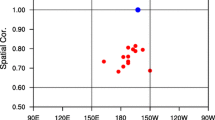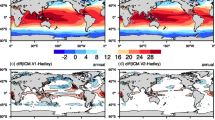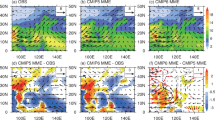Abstract
Previous observational studies have documented that the occurrence frequency of El Niño Modoki is closely linked to the North Pacific Oscillation (NPO). The present paper evaluates the relationships between the frequency of El Niño Modoki and the NPO in the historical runs of the Coupled Model Intercomparison Project Phase 5 (CMIP5) and examines the related physical processes. It is found that six of 25 CMIP5 models can reproduce both the spatial patterns of the NPO and El Niño Modoki. Four of these six models exhibit good performance in simulating the positive correlation between the NPO index and the frequency of El Niño Modoki. The analyses further show that the key physical processes determining the relationships between the NPO and the frequency of El Niño Modoki are the intensity of wind-evaporation-SST (WES) feedback in the subtropical northeastern North Pacific. This study enhances the understanding of the connections between the North Pacific mid-latitude climate system and El Niño Modoki, and has an important implication for the change of El Niño Modoki under global warming. If global warming favors to produce an oceanic and atmospheric pattern similar to the positive phase of the NPO in the North Pacific, more El Niño Modoki events will occur in the tropical Pacific with the assistance of the WES feedback processes.








Similar content being viewed by others
References
Anderson BT, Furtado JC, Cobb KM, Di Lorenzo E (2013b) Extratropical forcing of El Niño–Southern Oscillation asymmetry. Geophys Res Lett 40:4916–4921
Ashok K, Behera SK, Rao SA, Weng H, Yamagata T (2007) El Niño Modoki and its possible teleconnection. J Geophys Res 112:C11007
Bond NA, Overland JE, Spillane M, Stabeno P (2003) Recent shifts in the state of the north Pacific. Geophys Res Lett 30:2183. https://doi.org/10.1029/2003GL018597
Bretherton CS, Widmann M, Dymnidov VP, Wallace JM, Blade I (1999) The effective number of spatial degrees of freedom of a time-varying field. J Clim 12:1990–2009
Chang P, Zhang L, Saravanan R, Vimont DJ, Chiang JCH, Ji L, Seidel H, Tippett MK (2007) Pacific meridional mode and El Niño–Southern Oscillation. Geophys Res Lett 34:L16608. https://doi.org/10.1029/2007GL030302
Chiang J, Vimont D (2004) Analogous Pacific and Atlantic meridional modes of tropical atmosphere–ocean variability. J Clim 17:4143–4158
Deser C, Phillips AS, Tomas RA et al (2012) ENSO and Pacific decadal variability in community climate system model version 4. J Clim 25:2622–2651
Di Lorenzo E, Schneider N, Cobb KM et al (2008) North Pacific Gyre oscillation links ocean climate and ecosystem change. Geophys Res Lett 35:L08607
Di Lorenzo E, Cobb KM, Furtado JC, Schneider N, Anderson BT, Bracco A, Alexander MA, Vimont DJ (2010) Central Pacific El Niño and decadal climate change in the north Pacific Ocean. Nat Geosci 3:762–765
Ding RQ, Li JP, Tseng YH, Sun C, Guo Y (2015a) The Victoria mode in the north Pacific linking extratropical sea level pressure variations to ENSO. J Geophys Res Atmos 120:27–45. https://doi.org/10.1002/2014JD022221
Ding RQ, Li JP, Tseng YH (2015b) The impact of south Pacific extratropical forcing on ENSO and comparisons with the north Pacific. Clim Dyn 44:2017–2034. https://doi.org/10.1007/s00382-014-2303-5
Ding RQ, Li JP, Tseng YH, Sun C, Zheng F (2016) Linking a sea level pressure anomaly dipole over north America to the central Pacific El Niño. Clim Dyn. https://doi.org/10.1007/s00382-016-3389-8
Ding RQ, Li JP, Tseng YH, Sun C, Xie F (2017) Joint impact of north and south Pacific extratropical atmospheric variability on the onset of ENSO events. J Geophys Res Atmos. https://doi.org/10.1002/2016JD025502
Furtado JC, Di Lorenzo E, Anderson BT, Schneider N (2012) Linkages between the north Pacific oscillation and central tropical Pacific SSTs at low frequencies. Clim Dyn 39:2833–2846
Ham YG, Kug JS, Park JY, Jin FF (2013) Sea surface temperature in the north tropical Atlantic as a trigger for El Niño/Southern Oscillation events. Nat Geosci 6:112–116
Jin D, Kirtman BP (2009) Why the southern hemisphere ENSO responses lead ENSO? J Geophys Res 114:D23101. https://doi.org/10.1029/2009JD012657
Kalnay E, Kanamitsu M, Kistler R et al (1996) The NCEP/NCAR 40-year reanalysis project. Bull Am Meteorol Soc 77:437–471
Kao HY, Yu JY (2009) Contrasting eastern-Pacific and central-Pacific types of ENSO. J Clim 22:615–632
Kim ST, Yu JY (2012) The two types of ENSO in CMIP5 models. Geophys Res Lett 39:L11704. https://doi.org/10.1029/2012GL052006
Kim HM, Webster PJ, Curry JA (2009) Impact of shifting patterns of Pacific Ocean warming on north Atlantic tropical cyclones. Science 325:77–80
Kug JS, Jin FF, An SI (2009) Two types of El Niño events: cold tongue El Niño and warm pool El Niño. J Clim 22:1499–1515
Larkin NK, Harrison DE (2005) Global seasonal temperature and precipitation anomalies during El Niño autumn and winter. Geophys Res Lett 32:L16705
Lin CY, Yu JY, Hsu HH (2015) CMIP5 model simulations of the Pacific meridional mode and its connection to the two types of ENSO. Int J Climatol 35:2352–2358. https://doi.org/10.1002/joc.4130
Ma J, Yu JY (2014) Linking centennial surface warming patterns in the equatorial Pacific to the relative strengths of the Walker and Hadley circulations. J Atmos Sci 71:3454–3464
Ma J, Xie SP, Xu H (2017) Contributions of the North Pacific meridional mode to ensemble spread of ENSO prediction. J Clim 30(22):9167–9181
Mantua NJ, Hare SR, Zhang Y, Wallace JM, Francis RC (1997) A Pacific interdecadal climate oscillation with impacts on salmon production. Bull Am Meteorol Soc 78:1069–1079
Mo KC (2010) Interdecadal modulation of the impact of ENSO on precipitation and temperature over the United States. J Clim 23:3639–3656
Park JY, Yeh SW, Kug JS, Yoon J (2013) Favorable connections between seasonal footprinting mechanism and El Niño. Clim Dyn 40:1169–1181
Rayner NA, Parker DE, Horton EB et al (2003) Global analyses of sea surface temperature, sea ice, and night marine air temperature since the late nineteenth century. J Geophys Res 108:4407. https://doi.org/10.1029/2002JD002670
Ren HL, Jin FF (2011) Niño indices for two types of ENSO. Geophys Res Lett 38:L04704. https://doi.org/10.1029/2010GL046031
Rogers JC (1981) The north Pacific oscillation. J Climatol 1(1):39–57
Tan W, Wang X, Wang WQ, Wang CZ, Zuo JC (2016) Different responses of sea surface temperature in the south China Sea to various El Niño vvents during boreal autumn. J Clim 29:1127–1142
Taschetto AS, England MH (2009) El Niño Modoki impacts on Australian rainfall. J Clim 22:3167–3174
Taschetto AS, Gupta AS, Jourdain NC, Santoso A, Ummenhofer CC, England MH (2014) Cold tongue and warm pool ENSO events in CMIP5: mean state and future projections. J Clim 27:2861–2885
Vimont DJ, Battisti DS, Hirst AC (2001) Footprinting: a seasonal connection between the tropics and mid-latitudes. Geophys Res Lett 28:3923–3926. https://doi.org/10.1029/2001GL013435
Vimont DJ, Wallace JM, Battisti DS (2003a) The seasonal footprinting mechanism in the Pacific: implications for ENSO. J Clim 16:2668–2675
Vimont DJ, Battisti DS, Hirst AC (2003b) The seasonal footprinting mechanism in the CSIRO general circulation models. J Clim 16:2653–2667
Walker GT, Bliss EW (1932) World weather V. Mem Roy Meteor Soc 4:53–84
Wang CZ, Wang X (2013) Classifying El Niño Modoki I and II by different impacts on rainfall in Southern China and typhoon tracks. J Clim 26:1322–1338
Wang X, Wang CZ (2014) Different impacts of various El Niño events on the Indian Ocean dipole. Clim Dyn 42:991–1005
Wang X, Zhou W, Li C, Wang D (2014) Comparison of the impact of two types of El Niño on tropical cyclone genesis over the south China Sea. Int J Climatol 34:2651–2660. https://doi.org/10.1002/joc.3865
Wang CZ, Deser C, Yu JY, Di Nezio P, Clement A (2016) El Niño-Southern Oscillation (ENSO): a review. In: Glynn P, Manzello D, Enochs I (eds) Coral reefs of the eastern Pacific. Springer, Berlin, pp 85–106
Weng H, Ashok K, Behera SK, Rao SA (2007) Impacts of recent El Niño Modoki on dry/wet conditions in the Pacific rim during boreal summer. Clim Dyn 29:113–129
Xie SP, Philander SGH (1994) A coupled ocean–atmosphere model of relevance to the ITCZ in the eastern Pacific. Tellus 46A:340–350
Xu K, Tam C, Zhu C, Liu B, Wang W (2016) CMIP5 Projections of two types of El Niño and their related tropical precipitation in the 21st century. J Clim. https://doi.org/10.1175/JCLI-D-16-0413.1
Yeh SW, Kug JS, Dewitte B, Kwon MH, Kirtman BP, Jin FF (2009) El Niño in a changing climate. Nature 461:511–514. https://doi.org/10.1038/nature08316
Yeh SW, Wang X, Wang CZ, Dewitte B (2015) On the relationship between the north Pacific climate variability and the central Pacific El Niño. J Clim 28:663–677. https://doi.org/10.1175/JCLI-D-14-00137.1
Yu JY, Kao HY (2007) Decadal changes of ENSO persistence barrier in SST and ocean heat content indices: 1958–2001. J Geophys Res 112:D13106
Yu JY, Kim ST (2010) Identification of central-Pacific and eastern-Pacific types of ENSO in CMIP3 models. Geophys Res Lett 37(15):L15705
Yu JY, Kim ST (2011) Relationships between extratropical sea level pressure variations and the central Pacific and eastern Pacific types of ENSO. J Clim 24:708–720. https://doi.org/10.1175/2010JCLI3688.1
Yu JY, Kim ST (2013) Identifying the types of major El Niño events since 1870. Int J Climatol 33(8):2105–2112
Yu JY, Kao HY, Lee T (2010) Subtropical-related interannual sea surface temperature variability in the central equatorial Pacific. J Clim 23:2869–2884. https://doi.org/10.1175/2010JCLI3171.1
Yu JY, Lu MM, Kim ST (2012a) A change in the relationship between tropical central Pacific SST variability and the extratropical atmosphere around 1990. Environ Res Lett 7:034025. https://doi.org/10.1088/1748-9326/7/3/034025
Yu JY, Zou Y, Kim ST, Lee T (2012b) The changing impact of El Niño on US winter temperatures. Geophys Res Lett 39:L15702. https://doi.org/10.1029/2012GL052483
Yu JY, Wang X, Yang S, Paek H, Chen MY (2017) Changing El Nino-southern oscillation and associated climate extremes. Book chapter in climate extremes: patterns and mechanisms. In: Wang S-Y, Jin-Ho Y, Chris F, Gillies RR (eds) AGU geophysical monograph series, vol 226, pp 3–38. AGU, Washington, DC
Yuan Y, Yang S (2012) Impacts of different types of El Niño on east Asian climate: focus on ENSO cycles. J Clim 25:7702–7722
Zhang Y, Wallace JM, Battisti DS (1997) ENSO-like interdecadal variability. J Clim 10:1004–1020
Acknowledgements
This work was supported by the CAS/SAFEA International Partnership Program for Creative Research Teams, the Strategic Priority Research Program of the Chinese Academy of Sciences (Grant no. XDA11010403), the National Natural Science Foundation of China (Grant nos. 41422601, 41376025 and 41731173), the Leading Talents of Guangdong Province Program, the Pioneer Hundred Talents Program of the Chinese Academy of Sciences, the National Program on Global Change and Air-Sea Interaction (GASI-IPOVAI-04). SWY was supported by the Korea Meteorological Administration Research and Development Program under grant KMIPA2015-1042.
Author information
Authors and Affiliations
Corresponding author
Rights and permissions
About this article
Cite this article
Wang, X., Chen, M., Wang, C. et al. Evaluation of performance of CMIP5 models in simulating the North Pacific Oscillation and El Niño Modoki. Clim Dyn 52, 1383–1394 (2019). https://doi.org/10.1007/s00382-018-4196-1
Received:
Accepted:
Published:
Issue Date:
DOI: https://doi.org/10.1007/s00382-018-4196-1




